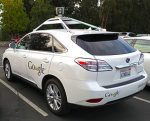A few years ago, I was watching a movie that featured autonomous vehicles and high-end artificial intelligence [AI] which, interestingly, is a common theme of movies and books since at least Isaac Asimov’s time. This particular movie scene features the AI attempting to eliminate a human target by directing the autonomous vehicle and other robots to a fatal end. Fortunately, the vehicle has optional manual controls, which robots actually try to circumvent manually, saying, “you are experiencing an accident.”
Now, I’m not expecting this to occur anytime soon, but as vehicle control systems become more complicated and more capable, more responsibilities have been taken out of the driver’s hands, which may, or may not, be a good thing, and we haven’t even taken the steering wheel out of the driver’s hands yet. Take, for example, various systems that are already available on vehicles today.

Vehicle Safety Systems – The First Step
Anti-lock brakes [ABS], as the name implies, keep the brakes from locking up and setting the vehicle into a skid. On slippery road surfaces, ABS can help you keep control of your vehicle. Vehicle skid control [VSC] or electronic stability control [ESC] can adjust power output to keep the vehicle in its intended path, even when the road is slick. Newer technology, such as lane keep assistance [LKA], uses video cameras to keep track of the lines in the highway. If you drift near the line, LKA alerts you and can even nudge electronic power steering [EPS] back in the right direction. Blind spot monitoring [BSM] alerts the driver attempting to make a highway lane change that there is another vehicle there, again notifying and even using EPS to keep the driver in his lane.
Now, here’s my question: “What have these systems really done for us?” I do not doubt that the roads are somewhat safer, thanks to these innovations, but I think what’s really happened is that we have forgotten how to drive. Driving a one-to-five ton wheeled vehicle in a variety of traffic and road conditions is a serious affair, requiring all of the driver’s attention.
What Have Drivers Lost?
Let’s go back to our list of acronyms and see what we’ve lost:
ABS, VSC, ESC – Actually, not a bad idea, and it’s required on pretty much every vehicle these days, but have we forgotten when it is safe to drive? Do we need to drive 85mph in a wind-driven rain? Sorry, fancy electronic systems aren’t going to keep you out of an accident in those conditions.
LKA, BSM, EPS – Here’s where things start to get sticky. LKA can keep you in your lane, but why? Should you be distracted by your smartphone or internet-connected audio/video/navigation system? Should you be dozing off because you are overtired and that last cup of coffee just didn’t cut it? If you’re making a lane-change at highway speeds, have you forgotten how to use your mirrors or turn your head? Sorry, you should have your full attention on the road, and you should be well-rested and alert.
Even Toyota’s technology website comes with the following disclosure regarding safety systems, such as VSC, which it describes as “an electronic system designed to help the driver maintain vehicle control under adverse conditions. It is not a substitute for safe driving practices. Factors including speed, road conditions and driver steering input can all affect whether VSC will be effective in preventing a loss of control.” [italics mine]
Autonomous Vehicles – The Next Step?
Self-driving cars are being hyped as the next big thing at the moment, with Nissan recently announcing plans to have an automonous vehicle by 2020. Sure, we read those words and understand them but, for the most part, people use these systems as a crutch. What will happen when even more responsibilities get take away from the driver? If we need simply to punch in a destination, the less we’ll know about how to act in varying road and traffic conditions, if and when we’d have to take manual control. And why would we ever have to take manual control of an autonomous vehicle? Debris, weather, wild and stray animals, and other drivers make the road an uncertain place to be in motion, and conditions can change in an instant. Ever-changing conditions require constant vigilance on the part of the driver and, even then, accidents are never unavoidable.
Even if, tomorrow, every single vehicle on the road was converted to autonomous function, internet- and intervehicle-connected, eliminating the driver from the equation, it will never be enough to cure congestion and keep travelers safe. Imagine allowing autonomous vehicles to transport us and never having to pay attention until those final few seconds called to act upon a new situation. The hand-off would be disastrous. Are we ready for this?
Author B. Jerew, a former master technician for Toyota and Lexus, is quickly becoming a leading voice in automotive technology. He writes for a number of automotive blogs and corporate entities, including New York Auto Finance (website), which provides automotive financial services for people in his home state of New York.





